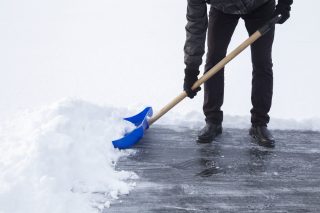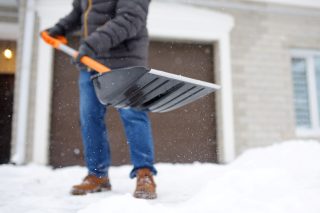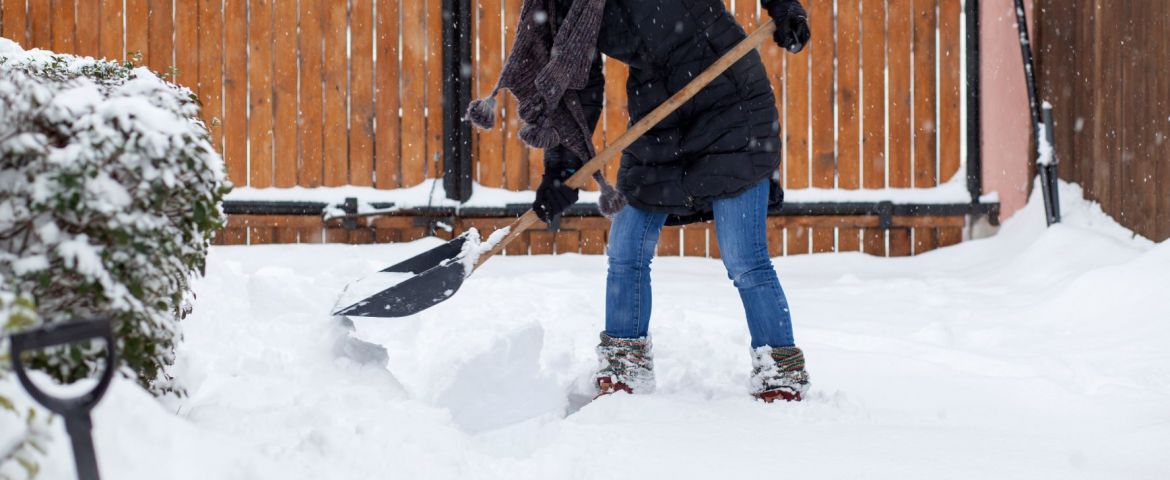As the snowflakes fall, it’s easy to feel overwhelmed by the thought of keeping our driveways, front paths and sidewalks clear. When we’re so focused on getting snow out of our way, we need to address shoveling snow just like any other strenuous sport for which we must train our body. Check out these helpful tips for safe snow removal to avoid strained muscles, back pain, or worst of all—a trip to the ER.
Consider any health risks.
If you’re out of shape, have back or other muscle problems, heart disease or another heart condition—it can actually be dangerous for you to shovel snow. If you haven’t already, this may be your year to hire a neighbor or contact a professional snow removal service to avoid injury or other serious medical issues.
Prep and plan before you step outside.
Feeling in good shape and up to the challenge? Follow these steps for safety before you head out to “muscle” snow around.
- Stretch your muscles just like you would before a race or workout to prevent injury. This is a workout, and your muscles need stretching! Round your back in a standing cat and cow pose to keep the lower lumbar limber, an area that is essential to shoveling.
- “Wax” your shovel blade to help snow slide off and on easier. Spray with a silicone lubricant—even vegetable oil from the kitchen can work well.
- Dress in layers to stay warm. You lose a large amount of body heat through your head, so remember to wear a hat. The warmer you stay outside, the less likely to get sick you are.
- Wear warm boots with traction. Good soles can help you with balance, especially on icy paths.
- Wear gloves to prevent blisters and keep your hands warm and dry.
- Use a shovel that is the correct length for your height to avoid any extra strain to the back.
Safety First.
Snow shoveling is an opportunity for multi-planar core fitness. Each time you head outside, remember that shoveling needs to be safe, and take the proper precautions like the steps outlined above) to make sure it is.
- Take breaks to check in with your body. Assess how you’re feeling to stay aware of overuse. Continuous snow shoveling can be hazardous to the health of those without robust heart health.
- Scoop small amounts of snow at a time so that it won’t be too heavy. Remember to avoid lifting too much weight at once. Skim a few inches off the top to take smaller amounts as needed.
- Switch off between shoveling right-handed and left-handed, so there’s equal opportunity for muscle balance and that you’re working both sides evenly.
- Stay hydrated. Drink plenty of water before, during and after. Shoveling can be hard physical work and you need to pace yourself. In the cold, you’re not as likely to feel thirsty, but dehydration can set in quickly. Take your time.
Know which muscles you’ll be using – and train them.
The plane of motion that shoveling has us work through is called the “transverse plane,” or the angle in which we move our spine and muscles in order to remove snow with a shovel. If your body is not prepared for stability and strength within this area, there’s an increased risk of injury. One way to get stronger with this plane of motion is with floor to overhead diagonal lifts using a medicine ball. Core strength is also the key to success when it comes to lifting something heavy out and away from our body. Contracting the gluteal muscles first ensures a much safer stance to lift or hoist for anything of substantial weight.
or the angle in which we move our spine and muscles in order to remove snow with a shovel. If your body is not prepared for stability and strength within this area, there’s an increased risk of injury. One way to get stronger with this plane of motion is with floor to overhead diagonal lifts using a medicine ball. Core strength is also the key to success when it comes to lifting something heavy out and away from our body. Contracting the gluteal muscles first ensures a much safer stance to lift or hoist for anything of substantial weight.
Bend and lift safely.
Shoveling involves a lot of bending and lifting; here are some quick tips to safely do so:
- Bend your knees, lift with your glutes first, then your legs. Let them do the bulk of the hard work. Your lower back will thank you for it.
- Lift correctly. Stand with your feet shoulder-width apart for balance and bend at the knees rather than at the waist or back. Keep the shovel close to your body rather than extending your arms all the way. Tighten your gluteus maximus, core and abdominal muscles—then lift with your legs as if you are doing a squat.
- Put your chest and upper back into it. Your chest and back are the next largest muscle groups after glutes and legs. Think about the muscles you should use for the task at hand and squeeze them as you lift heavy. Your smaller muscles in the shoulders and arms should not be the main movers and only help a little.
- Maintain good posture. Stand tall with your proper height shovel, soften the knees, draw your navel in and up toward your spine while bending down, scooping, then lifting. If possible, eliminate the twist or keep it to a minimum by tossing the snow more to the front of you. As you lift the snow, keep the shovel blade close to you, to reduce low back strain.
Spring will eventually come to the Mitten as it does every year, but until then—don’t let the winter snowfall overwhelm you. Following these tips and safety first, it’s possible to get a low-risk workout with the white stuff, it can even burn over 200 calories per every half hour.


